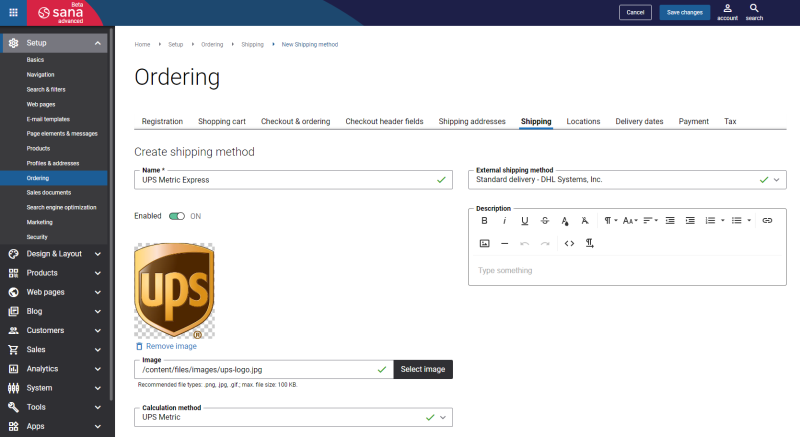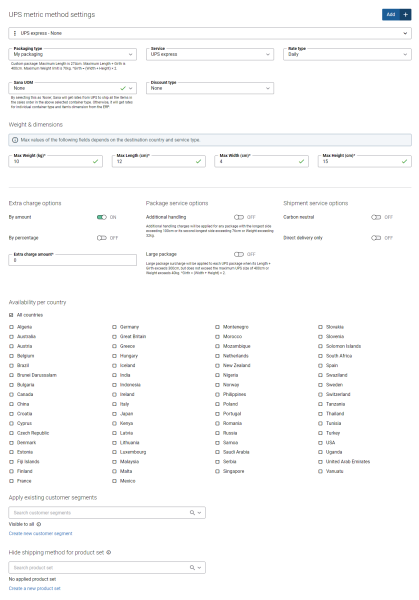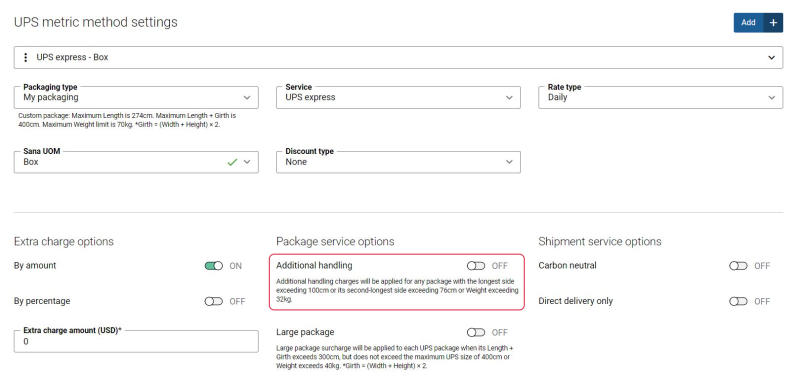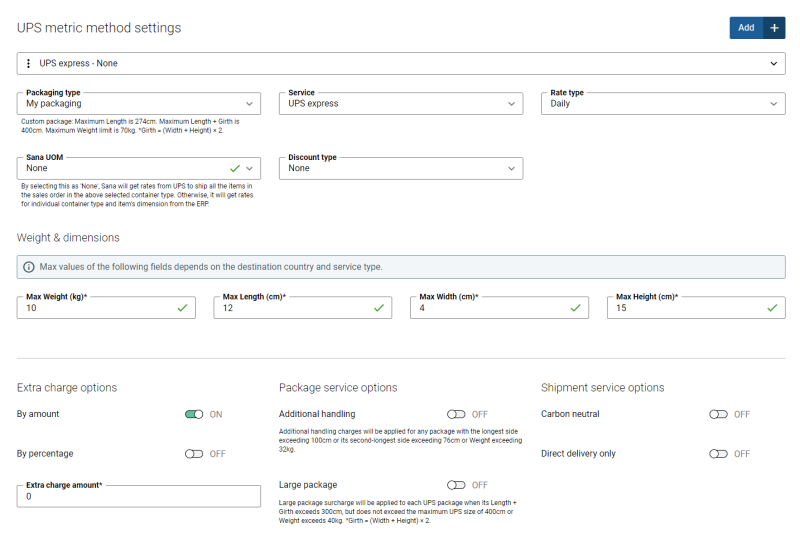Create UPS Metric Shipping Methods
When UPS Metric is installed and configured, the list of UPS Metric services is automatically available to create UPS Metric shipping methods.
Set Up UPS Metric Shipping Methods
Step 1: In Sana Admin click: Setup > Ordering > Shipping.
Step 2: Click Add shipping method to create a shipping method.
The table below provides the description of the fields and settings that should be configured when you create a UPS Metric shipping method.
|
Fields and settings |
Description |
|---|---|
|
Name |
Enter the name of the shipping method. |
|
Enabled |
Use this option to enable or disable the shipping method. You can also enable or disable shipping methods on the shipping methods list page. |
|
External shipping method |
Map the shipping method to the one configured in your ERP system. If the shipping method in Sana Admin is mapped to the shipping method in your ERP system, then when a customer places an order in the webstore, the selected shipping method will be stored in the sales order in the ERP system. Related ArticlesMicrosoft Dynamics NAV: Shipping Agents and Services |
|
Image |
Add an image icon of the shipping method. If you add an icon, it will be shown in the webstore in the list of delivery methods. |
|
Description |
You can add a description to the shipping method. Shipping method description is shown in the Sana webstore on the Delivery method checkout step, where customers can select the shipping method, they want their order to be delivered. |
|
Calculation method |
Select UPS Metric. The shipping costs are calculated by UPS Metric real-time depending on the UPS service type, customer's shipping address, actual weight and dimensions of the package. NOTE
The UPS Metric calculation method is available only when the Sana’s UPS Metric add-on is installed. |
Set Up the UPS Metric Method Settings
Once you select UPS Metric as a calculation method, the UPS Metric specific settings will be shown.
Below you can see the description of the UPS Metric specific fields and settings that should be configured when you create a shipping method.
Step 1: In the Packaging type dropdown, select the package type that should be used for delivery.
|
Packaging type |
Description |
|---|---|
|
My packaging |
Select for custom packages that do not belong to any of the UPS standard packaging types. If you select this option, you must specify the maximum weight and dimensions of your package in the Weight & dimensions section. |
|
Pallet |
Select for palletized shipments. A pallet is a low portable platform of wood, plastic, metal, fiberboard, or combinations thereof, that is elevated enough to allow forklift access. A pallet assists in consolidation and handling of packages and decreases the amount of time it takes to move packages. If you select this option, you must specify the maximum weight and dimensions of your package in the Weight & dimensions section. NOTE
The maximum weight and dimensions of the pallet depend on the country of destination. |
|
UPS express box - small |
Select for smaller shipments, such as books and tapes. |
|
UPS express box - medium |
|
|
UPS express box - large |
|
|
U.S. express PAK |
Select for protecting shipments of sensitive or regulated items that need a container of tear-resistant material. |
|
U.S. express pad PAK |
|
|
U.S. express hard PAK |
|
|
UPS tube |
Select for protecting documents that must be rolled in a triangular tube rather than folded. |
|
UPS letter |
Select for letter type shipments. |
Step 2: In the Service dropdown, select the type of service to be delivered by UPS according to the selected packaging type.
Step 3: Set up other UPS Metric settings:
|
Fields and settings |
Description |
|---|---|
|
Rate type |
Select the rate type based on which you will receive shipping charges for the UPS services. The available options are:
For more information, see UPS Shipping Rates. |
|
Sana UOM |
Select the unit of measure from the list available in Sana. The list of units of measure is retrieved from your ERP system. The selected unit of measure is mapped to the UPS packaging type. |
|
Discount type |
Select the discount type for the UPS Metric shipping method. The available options are:
To receive the negotiated rates, a user must enter a valid shipper number in the settings of the UPS Metric add-on. When you select the Negotiated discount type and the shipper number is authorized for web / promotional discounts, a user will receive the negotiated rates. For more information, see UPS Account-Specific Negotiated Rates.
|
|
Max Weight (kg) |
The Weight & dimensions section is available only when in the Packaging type field, you select either My packaging or Pallet, and Sana UOM is set to None. If you select these options, you must specify the maximum weight (in kilograms) and dimensions (in centimeters) of the UPS Metric packaging type. Use integer numbers to specify the maximum weight and dimensions of the package. UPS does not support decimal numbers. The Weight & dimensions section is used for custom packages and pallets that do not belong to any of the UPS standard packaging types. |
|
Max Length (cm) |
|
|
Max Width (cm) |
|
|
Max Height (cm) |
|
|
Extra charge amount (USD) |
You can set an extra charge for a shipment. It can be a fixed amount or percentage. |
|
Extra charge percentage (%) |
|
|
Additional handling |
Use this option to enable or disable the additional handling charges for specific shipments. For more information, see Additional Handling and UPS Special Care. |
|
Large package |
NOTE
Currently, this option is not supported. Use this option to enable or disable the large package surcharge for specific shipments. For more information, see UPS Special Care. |
|
Carbon neutral |
Use this option to enable or disable the carbon neutral shipments. UPS’s carbon neutral option supports projects that offset the emissions of the shipment’s transport. For more information, see UPS Carbon Neutral Parcel Service. |
|
Direct delivery only |
Use this option to enable or disable the direct delivery of your package. Direct delivery only ensures that a package is delivered to the residential or commercial address you provide. For more information, see UPS Direct Delivery Only. |
|
Availability per country |
Select countries for which the shipping method should be available. If some country is not selected, the shipping method will not be available to the customers of that country. |
|
Customer segments |
Assign customer segments. Using customer segments you can filter shipping methods. If you add a customer segment to the shipping method, then this shipping method will be available only to the customers that meet the criteria set in the customer segment. Other customers will not see this shipping method. |
|
Product set |
Use this field to select an existing product set or create a new one. You can assign a product set to a shipping method if you want to make it unavailable for certain products. If there is at least one product in the shopping cart from the selected product set, the shipping method will not be shown at the checkout. This can be useful if you are selling products that you know for sure cannot be delivered by a certain method or delivery service. For more information, see Product Sets. |
Additional Handling
Use the Additional handling package service option to enable or disable the additional handling charges for specific shipments.
Scenarios When Additional Handling Charges Are Not Applied to the Shipments
The Additional handling option is disabled.
Scenario 1
The longest side of the package does not exceed 100cm.
For example, the package’s dimensions are 90cm × 1cm × 1cm (Length × Width × Height); weight limit 10kg.
Scenario 2
The second-longest side of the package does not exceed 76cm.
For example, the package’s dimensions are 60cm × 77cm × 25cm (Length × Width × Height); weight limit 10kg.
Scenario 3
The actual weight of the package does not exceed 32kg.
For example, the package’s dimensions are 15cm × 30cm × 10cm (Length × Width × Height); weight limit 31kg.
Scenarios When Additional Handling Charges Are Always Applied to the Shipments
The additional handling charges will be automatically applied, even if the option Additional handling is disabled.
Scenario 1
The longest side of the package exceeds 100cm.
For example, the package’s dimensions are 101cm × 1cm × 1cm (Length × Width × Height); weight limit 10kg.
Scenario 2
The second-longest side of the package exceeds 76cm.
For example, the package’s dimensions are 90cm × 77cm × 10cm (Length × Width × Height); weight limit 10kg.
Scenario 3
The actual weight of the package exceeds 32kg.
For example, the package’s dimensions are 30cm × 15cm × 12cm (Length × Width × Height); weight limit 40kg.
Scenarios When Additional Handling Charges Are Intentionally Applied to the Shipments
The Additional handling option is enabled.
The package’s dimensions do not exceed the maximum weight and dimensions or are within the range described in the scenarios below.
Scenario 1
The longest side of the package does not exceed 100cm.
For example, the package’s dimensions are 10cm × 1cm × 1cm (Length × Width × Height); weight limit 10kg.
Scenario 2
The second-longest side of the package does not exceed 76cm.
For example, the package’s dimensions are 65cm × 32cm × 10cm (Length × Width × Height); weight limit 10kg.
Scenario 3
The actual weight of the package does not exceed 32kg.
For example, the package’s dimensions are 30cm × 15cm × 12cm (Length × Width × Height); weight limit 40kg.
When you configure UPS Metric shipping methods, you should also take into consideration the requirements below. On the screenshot below you can see a block of UPS Metric specific fields and settings.
-
At least one block of the UPS Metric specific fields and settings must be configured for a shipping method.
-
One shipping method can have multiple blocks of the UPS Metric specific fields and settings. If you need to add more blocks, click on the Add button. If you want to delete a block, click on the Delete button
 .
. -
You cannot set up a UPS Metric shipping method with multiple configurations for the same UPS Packaging type and Sana UOM for a single shipping method.
-
If in the Packaging Type field, you select either My packaging or Pallet, and in the Sana UOM field, you select None, then it is required to enter maximum dimensions and weight of the package.
Item’s Units of Measure and Shipping Rates
Scenarios When UPS Returns a Shipping Rate (Based on the Item’s Unit of Measure)
Scenario 1
A customer has an item which is configured in the ERP system with the following item dimensions.
|
Unit of measure |
Weight |
Length |
Width |
Height |
|---|---|---|---|---|
|
Piece |
20kg |
13cm |
11cm |
2cm |
A user created a UPS Metric shipping method in Sana Admin, for example as shown in the table below.
|
Packaging type |
Service |
Rate type |
Sana UOM |
Discount type |
Extra charge amount |
Extra charge percentage |
|---|---|---|---|---|---|---|
|
UPS express box - small |
UPS express |
Retail |
Piece |
None |
0 |
0 |
The unit of measure configured in ERP matches the unit of measure set in the Sana UOM field in the UPS Metric shipping method settings.
Result:
In this case, UPS will return a shipping rate because the item’s unit of measure in ERP and the UPS Metric shipping method’s unit of measure specified in the Sana UOM field are the same.
Also, UPS will return a shipping rate only if the item’s dimensions in ERP do not exceed the maximum item dimensions allowed by UPS.
Scenario 2
A customer has items which are configured in the ERP system with the following item dimensions.
|
Unit of measure |
Weight |
Length |
Width |
Height |
|---|---|---|---|---|
|
Piece |
20kg |
13cm |
11cm |
2cm |
|
Box |
40kg |
13cm |
11cm |
2cm |
|
KG |
21kg |
13cm |
11cm |
2cm |
|
L |
30kg |
13cm |
11cm |
2cm |
A user created a UPS Metric shipping method with multiple configurations for the same UPS packaging type and service, but different units of measure in Sana Admin, for example as shown in the table below.
|
Packaging type |
Service |
Rate type |
Sana UOM |
Discount type |
Extra charge amount |
Extra charge percentage |
|---|---|---|---|---|---|---|
|
UPS express box - small |
UPS express |
Retail |
Piece |
None |
0 |
0 |
|
UPS express box - small |
UPS express |
Retail |
Box |
None |
0 |
0 |
|
UPS express box - small |
UPS express |
Retail |
KG |
None |
0 |
0 |
|
UPS express box - small |
UPS express |
Retail |
L |
None |
0 |
0 |
The units of measure configured in ERP match the units of measure set in the Sana UOM field in the UPS Metric shipping method settings.
Result:
In the shopping cart there are 4 different items with 4 different units of measure.
In this case, UPS will return a shipping rate because the items’ units of measure in ERP and the UPS Metric shipping method’s units of measure specified in the Sana UOM fields in multiple configurations of the UPS Metric shipping method are the same.
The shipping rates for each item are calculated separately and then, the amount of these shipping rates is summed up. That amount will be the final shipping cost.
Scenarios When UPS Does Not Return a Shipping Rate (Based on the Item’s Unit of Measure)
Scenario 1
A customer has an item which is configured in the ERP system with the following item dimensions.
|
Unit of measure |
Weight |
Length |
Width |
Height |
|---|---|---|---|---|
|
Piece |
20kg |
13cm |
11cm |
2cm |
A user created a UPS Metric shipping method in Sana Admin, for example as shown in the table below.
|
Packaging type |
Service |
Rate type |
Sana UOM |
Discount type |
Extra charge amount |
Extra charge percentage |
|---|---|---|---|---|---|---|
|
UPS express box - small |
UPS express |
Retail |
Box |
None |
0 |
0 |
The unit of measure configured in ERP differs from the unit of measure set in the Sana UOM field in the UPS Metric shipping method settings.
Result:
In this case, UPS will not return a shipping rate because the item’s unit of measure in ERP and the UPS Metric shipping method’s unit of measure specified in the Sana UOM field do not match.
Scenario 2
A customer has items which are configured in the ERP system with the following item dimensions.
|
Unit of measure |
Weight |
Length |
Width |
Height |
|---|---|---|---|---|
|
Piece |
20kg |
13cm |
11cm |
2cm |
|
Box |
40kg |
13cm |
11cm |
2cm |
|
KG |
21kg |
13cm |
11cm |
2cm |
|
L |
30kg |
13cm |
11cm |
2cm |
A user created a UPS Metric shipping method with multiple configurations in Sana Admin, for example as shown in the table below.
|
Packaging type |
Service |
Rate type |
Sana UOM |
Discount type |
Extra charge amount |
Extra charge percentage |
|---|---|---|---|---|---|---|
|
UPS express box - small |
UPS express |
Retail |
Piece |
None |
0 |
0 |
|
UPS express box - small |
UPS express |
Retail |
Box |
None |
0 |
0 |
|
UPS express box - small |
UPS express |
Retail |
KG |
None |
0 |
0 |
|
UPS express box - small |
UPS express |
Retail |
L |
None |
0 |
0 |
|
UPS express box - small |
UPS next day air |
Retail |
Hour |
None |
0 |
0 |
The units of measure configured in ERP match the units of measure set in the Sana UOM field in the UPS Metric shipping method settings.
Result:
In the shopping cart there are 4 different items with 4 different units of measure. These are the first 4 items from the table above.
The items’ units of measure in ERP and the UPS Metric shipping method’s units of measure specified in the Sana UOM fields in multiple configurations of the UPS Metric shipping method match.
However, there are no items in the shopping cart with the UOM Hour that is configured in the shipping method.
In this case, UPS will not return a shipping rate.
Scenarios When UPS Returns a Shipping Rate (When the Value in the Sana UOM Field is Set to None)
Scenario 1
A customer has an item which is configured in the ERP system with the following item dimensions.
|
Unit of measure |
Weight |
Length |
Width |
Height |
|---|---|---|---|---|
|
Piece |
1kg |
1cm |
1cm |
1cm |
A user created a UPS Metric shipping method in Sana Admin, for example as shown in the table below. A user set the value in the Sana UOM field to None.
|
Packaging type |
Service |
Rate type |
Sana UOM |
Discount type |
Extra charge amount |
Extra charge percentage |
|---|---|---|---|---|---|---|
|
UPS express box - small |
UPS express |
Retail |
None |
None |
0 |
0 |
Result:
In this case, UPS will return a shipping rate even though item’s unit of measure in ERP and the UPS Metric shipping method’s unit of measure specified in the Sana UOM field differ. The UPS Metric shipping method does not consider item’s unit of measure in ERP when the value in the Sana UOM field is set to None.
Scenario 2
A customer has items which are configured in the ERP system with the following item dimensions.
|
Unit of measure |
Weight |
Length |
Width |
Height |
|---|---|---|---|---|
|
Piece |
1kg |
1cm |
1cm |
1cm |
|
Box |
2kg |
2cm |
2cm |
2cm |
|
KG |
3kg |
3cm |
3cm |
3cm |
|
L |
4kg |
4cm |
4cm |
4cm |
A user created a UPS Metric shipping method with multiple configurations for the same UPS packaging type, but different units of measure in Sana Admin, for example as shown in the table below. For one of the UPS Metric shipping methods, a user set the value in the Sana UOM field to None.
|
Packaging type |
Service |
Rate type |
Sana UOM |
Discount type |
Extra charge amount |
Extra charge percentage |
|---|---|---|---|---|---|---|
|
UPS express box - small |
UPS express |
Retail |
Piece |
None |
0 |
0 |
|
UPS express box - small |
UPS express plus |
Retail |
Box |
None |
0 |
0 |
|
UPS express box - small |
UPS express saver |
Retail |
KG |
None |
0 |
0 |
|
UPS express box - small |
UPS express expedited |
Retail |
None |
None |
0 |
0 |
Result:
In this case, UPS will calculate shipping rates separately for the items which units of measure in ERP and shipping method settings match, and the one that does not match will be calculated regardless of the item unit of measure in ERP as there is a shipping method configuration with the None Sana UOM.
The shipping rates for each item are calculated separately and then, the amount of these shipping rates is summed up. That amount will be the final shipping cost.
Scenario When UPS Does Not Return a Shipping Rate (When the Value in the Sana UOM Field is Set to None)
A customer has items which are configured in the ERP system with the following item dimensions.
|
Unit of measure |
Weight |
Length |
Width |
Height |
|---|---|---|---|---|
|
Piece |
1kg |
1cm |
1cm |
1cm |
|
KG |
2kg |
2cm |
2cm |
3cm |
A user created a UPS Metric shipping method with multiple configurations for the same UPS packaging and service types, but different units of measure in Sana Admin, for example as shown in the table below. For one of the UPS Metric shipping methods, a user set the value in the Sana UOM field to None.
|
Packaging type |
Service |
Rate type |
Sana UOM |
Discount type |
Extra charge amount |
Extra charge percentage |
|---|---|---|---|---|---|---|
|
UPS express box - small |
UPS express |
Retail |
None |
None |
0 |
0 |
|
UPS express box - small |
UPS express |
Retail |
Box |
None |
0 |
0 |
The units of measure configured in ERP differ from the units of measure set in the Sana UOM field in the UPS Metric shipping method settings.
Result:
In this case, UPS will not return a shipping rate because the item’s unit of measure in ERP and the UPS Metric shipping method’s unit of measure specified in the Sana UOM field do not match.
All items which do not meet the above mentioned scenarios will be packed into a separate container if they do not exceed weight and dimensions units allowed by UPS. If all items cannot be packed into one container, the remaining items will be packed in another container.



